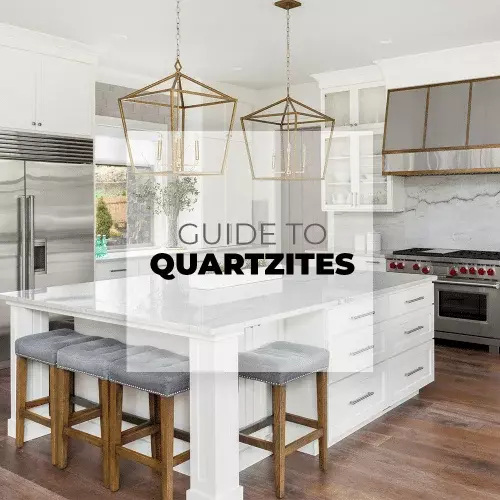
Complete Guide to Quartzites
Featured: Mont Blanc Quartzite
Natural stone is trending in contemporary architecture. The superior qualities of natural stone make it a versatile material that supports innovative design. Choosing a type of natural stone to work with depends on the level of durability, aesthetic appeal, versatility, and functionality required for a design.
Quartzite is an extremely hard, non-foliated metamorphic rock that is composed primarily of the mineral quartz. With durability, exquisite patterns, and a lustrous finish, quartzite slabs have the longevity of granite and the aesthetic of marble, making it the stone of choice for many architects and designers.
Let’s take a closer look at why quartzite is one of nature’s finest materials.
What is quartzite?
Quartzite begins its geological life as sand grains. Over several million years, the grains are compressed and bond together to form quartz sandstone. Tectonic compression creates pressure which buries the sandstone grains deeper under layers of rock. With enough heat, they melt, recrystallize, and cement together with silica and calcite. The result is an intricate network of quartz fused together to create one of nature’s most dense and durable stones.
Man-made quartz vs quartzite
Quartzite is often confused with the similar-sounding man-made quartz, but each material has completely different properties. Quartzite is a natural metamorphic stone formed within the earth, whereas quartz is a reconstituted man-made material composed of pieces of ground quartz, resin, and polymers. The reconstituted properties of quartz cause it to be much less heat and scratch resistant than quartzite. Due to the use of resin and polymers in man-made quartz, the product is not UV stable, meaning the colors will fade and yellow. Natural quartzite, on the other hand, is UV stable and will hold its finish for many years to come.
What makes quartzite unique?
Great architectural designs create harmony between aesthetic, functionality and durability. Quartzite ticks all of these boxes, making it an extremely versatile material.
Aesthetic
Quartzite is naturally beautiful and has a wide variety of colors and patterns. Whether it’s for a countertop, fireplace, patio, or pool, there are plenty of options for those who want to add a vibrant splash of color or stick to a minimal palette. The veining marble-Esque patterns also imbue a feeling of elegance to a space.
Durability
Quartzite is not just a pretty face. Due to the long metamorphic process, it takes to form, quartzite measures at 7 on the Mohs Hardness Scale. To put this into perspective, most quartzite slabs are harder than glass or a knife blade, and slightly more durable than granite and steel. As long as it’s sealed with a high-quality impregnating sealer, quartzite will last a lifetime.
Functionality
Quartzite is low-porous, low-maintenance, and easy to clean, making it an excellent contender when choosing a material for a stylish outdoor bar or pool area. It’s also popular in kitchens, particularly for those who like to cook or host. The density of quartzite means you don’t have to worry about scratching a benchtop while chopping food or etching it with acidic ingredients.
Why choose quartzite instead of marble or granite?
Quartzite is harder than marble and a better alternative if durability is a top priority. Although granite is highly durable and functional, quartzite has more exquisite patterns and colors if you are looking for a combination of durability and aesthetic.
At Avant Stone, we pride ourselves on having the highest quality quartzite slabs in Sydney. Natural stones are best viewed in person, so come and visit us in our centrally-located stone gallery to see and feel the quality of our quartzite slab collection for yourself.


